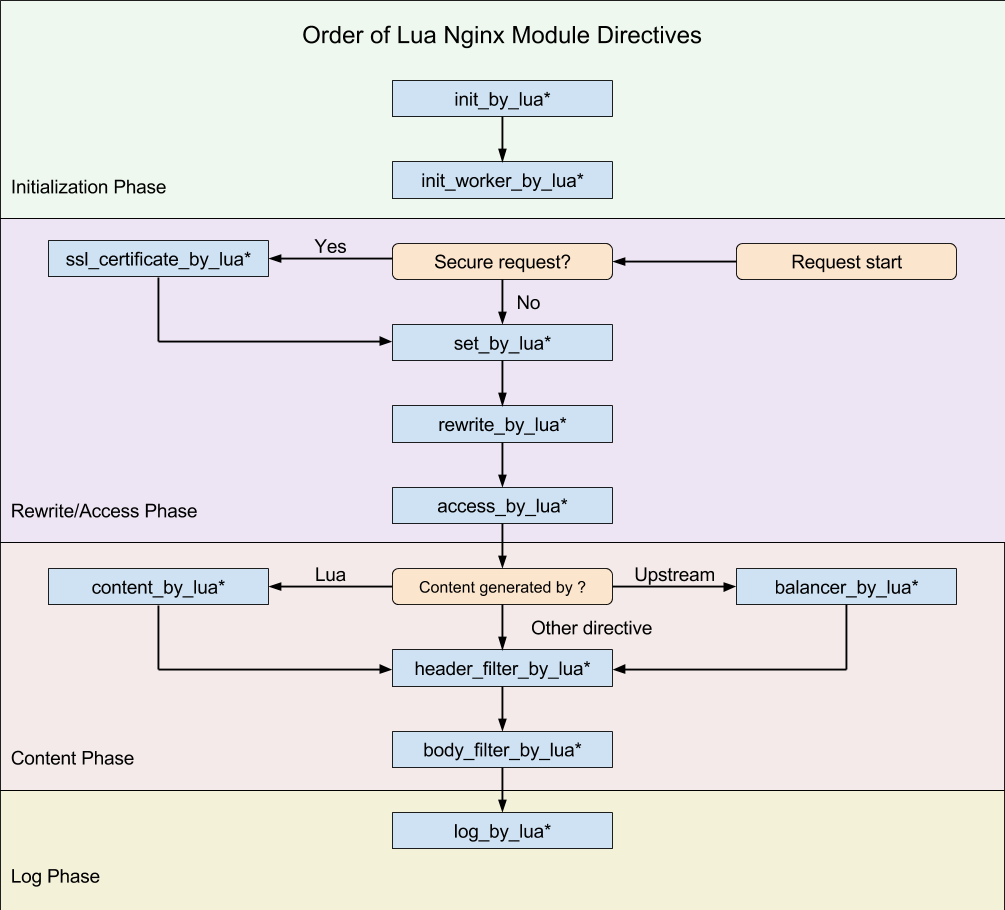# Nginx执行顺序
# Nginx 介绍
Nginx (engine x) 是一个高性能的HTTP和反向代理服务器,也是一个IMAP/POP3/SMTP服务器。Nginx是由伊戈尔·赛索耶夫为俄罗斯访问量第二的Rambler.ru站点(俄文:Рамблер)开发的,第一个公开版本0.1.0发布于2004年10月4日。
其将源代码以类BSD许可证的形式发布,因它的稳定性、丰富的功能集、示例配置文件和低系统资源的消耗而闻名。2011年6月1日,nginx 1.0.4发布。
Nginx是一款轻量级的Web 服务器/反向代理服务器及电子邮件(IMAP/POP3)代理服务器,并在一个BSD-like 协议下发行。其特点是占有内存少,并发能力强
Nginx 是一个很强大的高性能Web和反向代理服务器.
# Nginx执行顺序
location /test {
set $a 32;
echo $a;
set $a 56;
echo $a;
}
2
3
4
5
6
7
# Nginx 的阶段
Nginx 处理请求的过程一共划分为 11 个阶段,按照执行顺序依次是 post-read、server-rewrite、find-config、rewrite、post-rewrite、preaccess、access、post-access、try-files、content 以及 log
# post-read
set_real_ip_from、real_ip_header 最先执行的 post-read 阶段在 Nginx 读取并解析完请求头(request headers)之后就立即开始运行。标准模块 ngx_realip 就在 post-read 阶段注册了处理程序,它的功能是迫使 Nginx 认为当前请求的来源地址是指定的某一个请求头的值。下面这个例子就使用了 ngx_realip 模块提供的 set_real_ip_from 和 real_ip_header
server {
listen 8080;
set_real_ip_from 127.0.0.1;
real_ip_header X-My-IP;
location /test {
set $addr $remote_addr;
echo "from: $addr";
}
}
2
3
4
5
6
7
8
9
10
# server-rewrite
ngx_rewrite、set set_by_lua rewrite_by_lua post-read 阶段之后便是 server-rewrite 阶段。当 ngx_rewrite 模块的配置指令直接书写在 server 配置块中时,基本上都是运行在 server-rewrite 阶段
server {
listen 8080;
location /test {
set $b "$a, world";
echo $b;
}
set $a hello;
}
2
3
4
5
6
7
8
9
10
# find-config
这个阶段并不支持 Nginx 模块注册处理程序,而是由 Nginx 核心来完成当前请求与 location 配置块之间的配对工作。
location /hello {
echo "hello world";
}
2
3
# rewrite
set_unescape_uri set_by_lua rewrite_by_lua 由于 Nginx 已经在 find-config 阶段完成了当前请求与 location 的配对,所以从 rewrite 阶段开始,location 配置块中的指令便可以产生作用。当 ngx_rewrite 模块的指令用于 location 块中时,便是运行在这个 rewrite 阶段。另外, ngx_set_misc 模块的指令也是如此,还有 ngx_lua 模块的 set_by_lua 指令和 rewrite_by_lua 指令也不例外。
###post-rewrite
post-rewrite 阶段,不接受 Nginx 模块注册处理程序,而是由 Nginx 核心完成 rewrite 阶段所要求的“内部跳转”操作
server {
listen 8080;
location /foo {
set $a hello;
rewrite ^ /bar;
}
location /bar {
echo "a = [$a]";
}
}
2
3
4
5
6
7
8
9
10
11
12
“内部跳转”的工作原理:本质上其实就是把当前的请求处理阶段强行倒退到 find-config 阶段,以便重新进行请求 URI 与 location 配置块的配对。比如上例中,运行在 rewrite 阶段的 rewrite 指令就让当前请求的处理阶段倒退回了 find-config 阶段。由于此时当前请求的 URI 已经被 rewrite 指令修改为了 /bar,所以这一次换成了 location /bar 与当前请求相关联,然后再接着从 rewrite 阶段往下执行。
为什么不直接在 rewrite 指令执行时立即进行跳转呢? 为了在最初匹配的 location 块中支持多次反复地改写 URI
location /foo {
rewrite ^ /bar;
rewrite ^ /baz;
echo foo;
}
location /bar {
echo bar;
}
location /baz {
echo baz;
}
2
3
4
5
6
7
8
9
10
11
12
13
14
注意的:如果在 server 配置块中直接使用 rewrite 配置指令对请求 URI 进行改写,则不会涉及“内部跳转”
server {
listen 8080;
rewrite ^/foo /bar;
location /foo {
echo foo;
}
location /bar {
echo bar;
}
}
2
3
4
5
6
7
8
9
10
11
12
13
# preaccess
ngx_access-allow deny ngx_limit_req 和 ngx_limit_zone ngx_auth_request access_by_lua 注意的是:标准模块 ngx_realip 其实也在这个阶段注册了处理程序
server {
listen 8080;
location /test {
set_real_ip_from 127.0.0.1;
real_ip_header X-Real-IP;
echo "from: $remote_addr";
}
}
2
3
4
5
6
7
8
9
10
find-config 阶段远远晚于 post-read 阶段执行。
# post-access
不支持 Nginx 模块注册处理程序,而是由 Nginx 核心自己完成一些处理工作
# try-files
实现标准配置指令 try_files 的功能,并不支持 Nginx 模块注册处理程序。
location /account {
try_files $uri $uri/ /index.php$is_args$args;
}
2
3
由于 try_files 指令在许多 FastCGI 应用的配置中都有用到。 ry_files 指令接受两个以上任意数量的参数,每个参数都指定了一个 URI. 这里假设配置了 N 个参数,则 Nginx 会在 try-files 阶段,依次把前 N-1 个参数映射为文件系统上的对象(文件或者目录),然后检查这些对象是否存在。一旦 Nginx 发现某个文件系统对象存在,就会在 try-files 阶段把当前请求的 URI 改写为该对象所对应的参数 URI(但不会包含末尾的斜杠字符,也不会发生 “内部跳转”)。如果前 N-1 个参数所对应的文件系统对象都不存在,try-files 阶段就会立即发起“内部跳转”到最后一个参数(即第 N 个参数)所指定的 URI.
location /test {
try_files /foo /bar/ /baz;
echo "uri: $uri";
}
location /foo {
echo foo;
}
location /bar/ {
echo bar;
}
location /baz {
echo baz;
}
2
3
4
5
6
7
8
9
10
11
12
13
14
15
16
# content
echo proxy_pass content_by_lua balance_by_lua header_filter_by_lua body_filter_by_lua
# log
ngx log-acces error log_by_lua
openresty请求图

set_by_lua*: 流程分支处理判断变量初始化 rewrite_by_lua*: 转发、重定向、缓存等功能(例如特定请求代理到外网) access_by_lua*: IP 准入、接口权限等情况集中处理(例如配合 iptable 完成简单防火墙) content_by_lua*: 内容生成 header_filter_by_lua*: 响应头部过滤处理(例如添加头部信息) body_filter_by_lua*: 响应体过滤处理(例如完成应答内容统一成大写) log_by_lua*: 会话完成后本地异步完成日志记录(日志可以记录在本地,还可以同步到其他机器)
来自: http://blog.sina.com.cn/s/articlelist_1834459124_0_1.html https://openresty.org/download/agentzh-nginx-tutorials-zhcn.html#02-NginxDirectiveExecOrder01